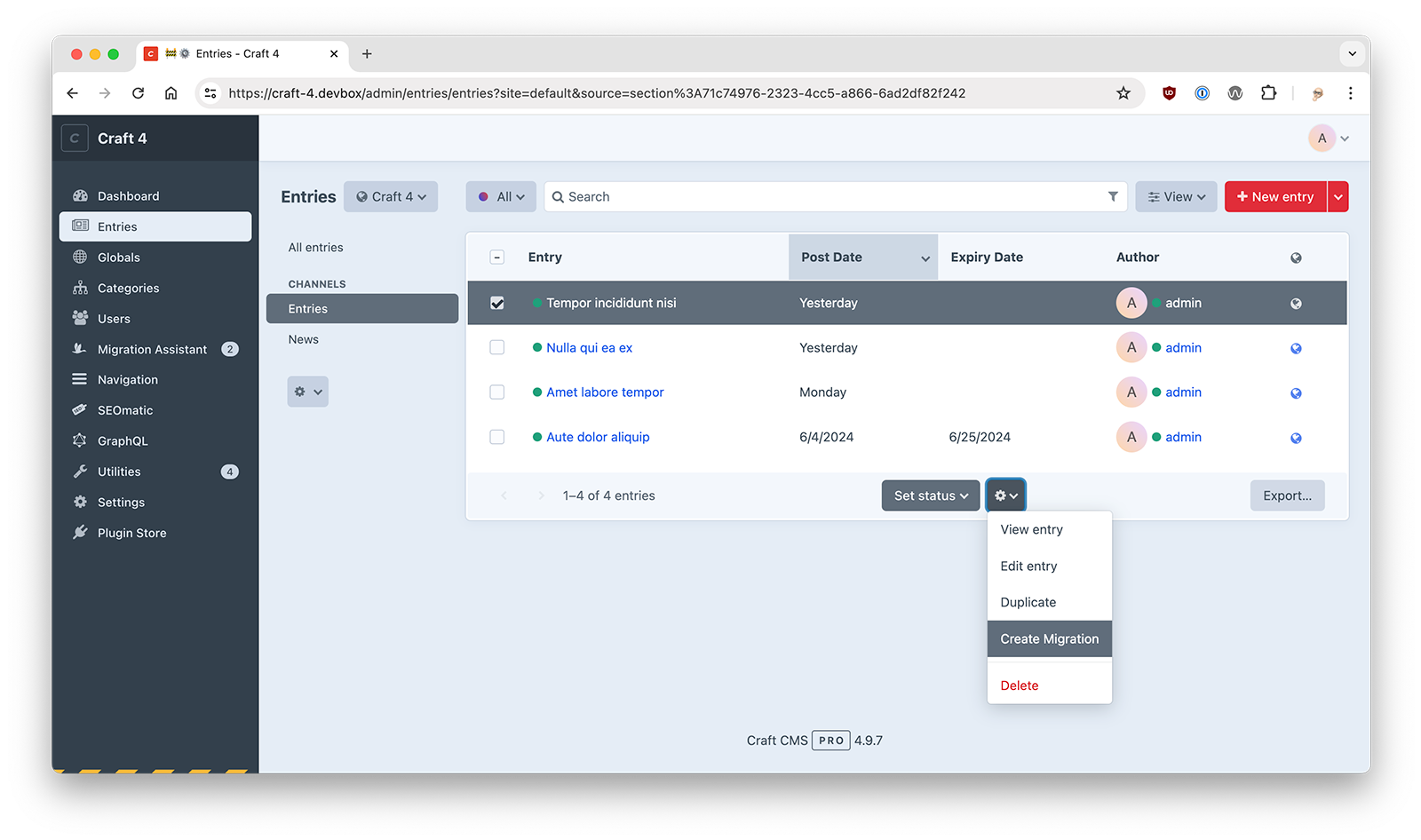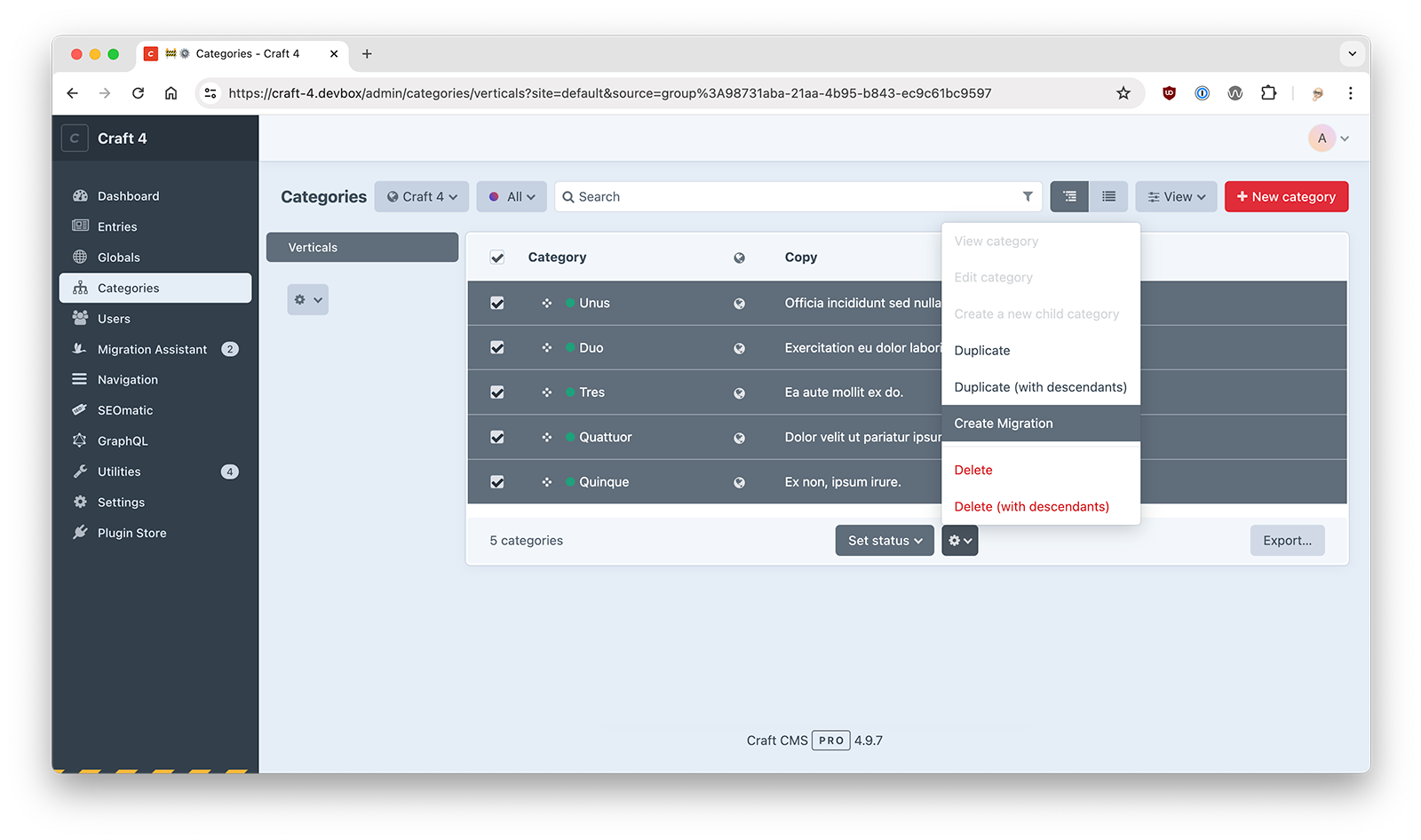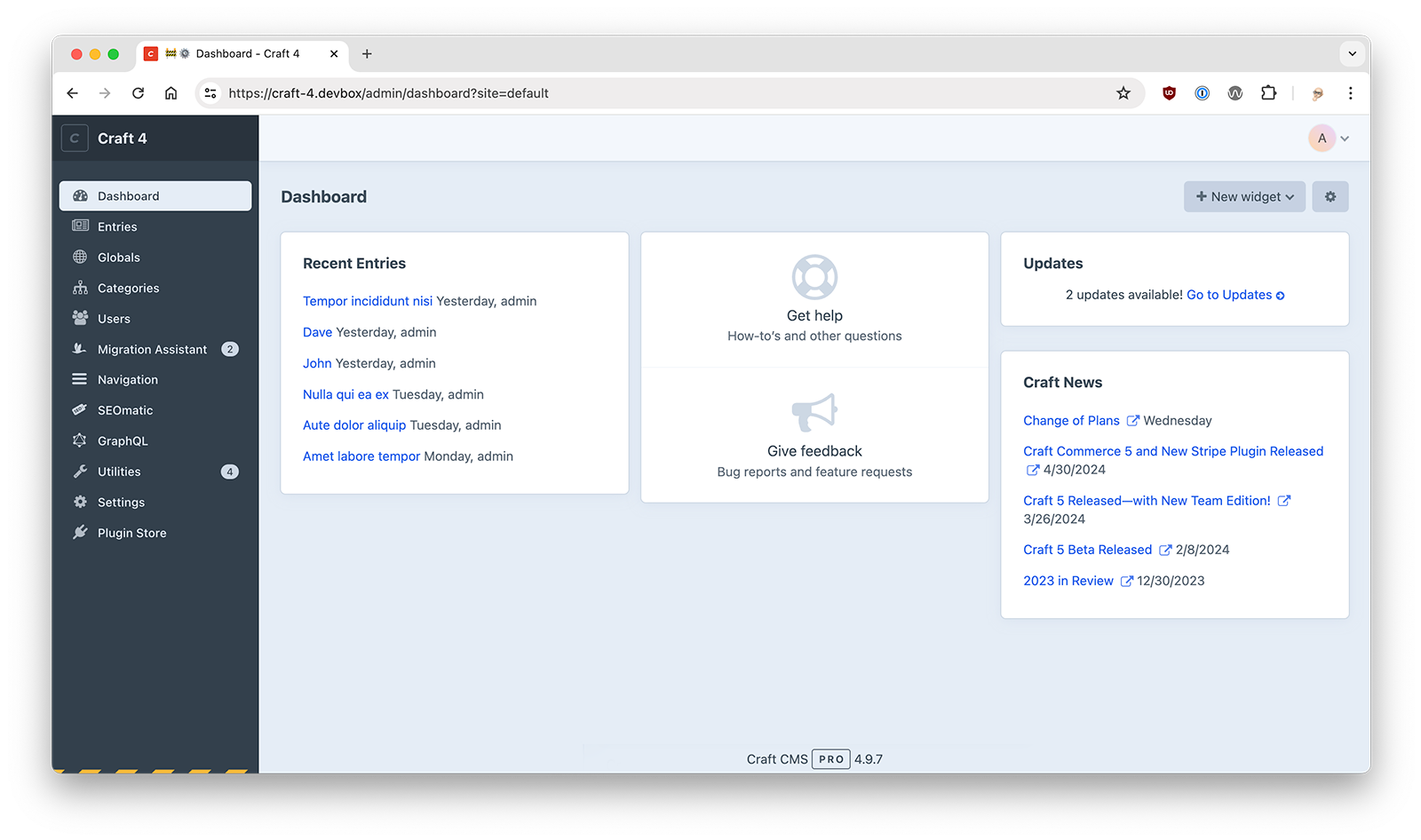Migration Assistant for Craft CMS 5
Create content migrations to easily move content between CraftCMS website installations. You can select which elements (entries, categories, users, globals) to migrate and create a native Craft content migration file that can be committed to your version control system. The migration(s) can then be applied on different CraftCMS installations to instantly create and update content, without needing to enter data multiple times. By using migrations you can ensure your various website environments (local, staging, production, etc.) stay in sync and up to date.
- In the Craft Control Panel, go to Settings -> Plugins
- Search for 'Migration Assistant'
- click the "Install" button
- Go to the command line and
cdto your project's root folder - Download the plugin via composer
composer require dgrigg/craft-migration-assistant - In the Craft Control Panel, go to Settings -> Plugins
- Click the "Install" button for Migration Assistant
The Migration Assistant can create content migrations for the following elements:
- entries
- categories
- globals
- users
To create a migration select the element(s) you wish to migrate and then click the gear and 'Create Migration' button at the bottom of the page. For Global values, use the 'Create Migration' button on the globals screen.
Content migrations are dependent on a workflow where you migrate related/dependent elements first. For example, if you have an entry that has some selected categories, the categories need to exist on the destination site before the entry migration will work correctly. This means creating a migration of the category(ies) first. This holds true for users, assets other other related entries/elements. In the case of assets you will need to ensure the matching asset (based on asset source/folder/filename) exists on the destination site.
A migration file will be created in the craft/migrations folder. The migration filename will contain the slugs/handles of the migrated elements. Move the new migration file to your destination environment, ideally with version control.
- In your development environment:
git add .
git commit -am 'new migration'
git push
- In your destination environment:
git pull
When new migration(s) are discovered in your destination environment a badge will appear to let you know. Click on the 'Migrations Assistant' tab and run the new migrations. You can run all the pending migrations by simply clicking the Run Migrations button or you can select individual migrations to run. You can also run migrations from the native Craft/Utilities/Migrations tab (this only allows you to run all pending migrations, not individual ones).
Migration Assistant uses Craft's built in migrator to run migrations. Failed migrations will be rolled back and the database will be returned to it's pre migration state. You can check the Craft logs and the Migration logs to see details on why the migration failed. In many instances it's simply a case of a migration having dependencies (ie required fields) that have not been setup on the destination site or a missing field/plugin.
You can also view previously applied migrations by clicking the 'Applied' tab on the migrationassistant/Migrations page. This will show you migrations that have already been applied and migrations that were created locally (and don't need to be run locally). Note that if you create blank migrations (by clicking the Create Migration button without selecting elements) they will show up in the New Migrations list, so that you have a chance to test and run them locally with your custom migration code.
You can run the migrations in a variety of ways. The two standard Craft ways are either via the cli ./craft migrate/all or via the Craft CP Utilities Migrations tab. Both of these methods run all available content migrations. There may be instances where you only want to run a single content migration. To do this use the 'Migration Assistant\Migrations' panel in the CP. You have the option to run one, multiple or all available migrations. You can also re-run previously applied migrations if the need arises.
Migration Assistant currently supports all core CraftCMS fields types:
- Addresses
- Assets
- Categories
- Checkboxes
- Color
- Country
- Date
- Dropdown
- Entries
- Icon
- Lightswitch
- Matrix
- Money
- Multi-select
- Number
- Plain Text
- Radio Buttons
- Table
- Tags
- Time
- Url
- Users
In addition it also supports:
To support additional field types and special content you can use event handlers for customized import/export functions. To handle export/import of custom field types your plugin/module should listen for the Export/Import events that are triggered from the BaseContentMigration class. Refer to the extensions/LinkFieldExtension.php to see how the export and import events can be used.
Following is the list of element types that the Migration Assistant has events for that allow you to modify the export/import data to support custom fields.
- Entries
- Categories
- Globals
- Users
During the export event you can modify the $event->value data to include any additional settings not already in the data to be exported. This is also the right place to update references to linked elements swapping our element id's for handles/slugs that are portable across environments.
@event ExportEvent - Triggered before an element is exported
const EVENT_BEFORE_EXPORT_ELEMENT = 'beforeExport';
@event ExportEvent - Triggered before an element field value is exported
const EVENT_BEFORE_EXPORT_FIELD_VALUE = 'beforeExportFieldValue';
@event ImportEvent - Triggered before an element is imported, can be cancelled
const EVENT_BEFORE_IMPORT_ELEMENT = 'beforeImport';
@event ImportEvent - Triggered before an element field value is imported
const EVENT_BEFORE_IMPORT_FIELD_VALUE = 'beforeImportFieldValue';
@event ImportEvent - Triggered before an element is imported
const EVENT_AFTER_IMPORT_ELEMENT = 'afterImport';
//Custom field example
Event::on(Fields::class, Fields::EVENT_BEFORE_EXPORT_ELEMENT, function(ExportEvent $event) {
$value = $event->value;
$value['settings']['special_setting'] = 'some special setting value';
$event->value = $value;
});During the import you can modify the data before it is imported or deal with the element after it has been imported and either created or updated.
Before import, the $event->element is the element model (based on handle match) to be imported (updated or created). The $event->value property is the raw data used to populate the element model. You can change properties in the $event->element and $event->value to affect the imported data. Refer to the extensions/LinkFieldExtension.php for an example
//Custom fields
Event::on(Fields::class, Fields::EVENT_BEFORE_IMPORT_ELEMENT, function(ExportEvent $event) {
$element = $event->element;
$element->special_value = $event->value['special_setting'];
$event->element = $element;
});After import you can access the $event->element and $event->value to perform additional operations related to the element if needed.
Event::on(Fields::class, Fields::EVENT_AFTER_IMPORT_ELEMENT, function(ExportEvent $event) {
$event->value['special_value'] = 'some special value';
});You can also cancel an import if needed and provide an error message. Error messages will be written to the Craft web log.
//Custom fields
Event::on(Fields::class, Fields::EVENT_BEFORE_IMPORT_ELEMENT, function(ExportEvent $event) {
$event->isValid = false;
$event->error = 'my reason for cancelling the imort';
});Any values in the field data that contains id's should be converted to handles/slugs or some string based value that can be looked up on the destination site without depending on matching id values as id values can differ between website database instances. Refer to the ElementHelper:getSourceHandle and ElementHelper:populateIds for more insight.
For importing custom fields the imported value should match the fields required input structure. Check the field type's documentation and code for help on determining the correct structure.
A special note about User migrations. Only 'content' for users is exported in a migration. This includes the user name, email, any custom field layout values (including addresses) and permissions. No password, user actiation, user login information is migrated.
By default all users with admin rights have full access to the Migration Assistant and the ability to create content migrations. Non admin users can be granted permissions to access the Migration Assistant and to create content migrations in the user/permissions section of Craft.
In addition to generated migrations you can use the MigrationManger to create empty migrations that can be used for tasks like deleting fields and creating content. To create an empty migration simply click the 'Create Migration' on the Migration Assistant/Create Migrations tab. A new empty migration will be added to the craft/migrations folder.
View the examples.
To learn more about creating custom migrations:
- Craft CMS Official - Content Migrations
- Craft CMS 3 Content Migration Examples
- Adding Content with Content Migrations in Craft CMS
Migration Assistant no longer includes migration support for fields, sections, settings, etc. Craft's core project config setup is a better mechanism for syncing Craft structure/settings across environments. Please note that migrations need to be generated and executed in the same Craft major versions due to changes in core Craft elements and services.
Flying Duck icon by Agne Alesiute from the Noun Project



